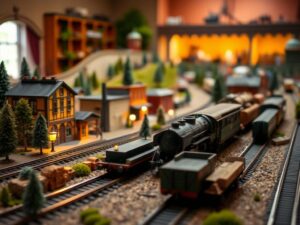How to Repair Damaged HO Scale Tracks
How to Repair Damaged HO Scale Tracks
How to Repair Damaged HO Scale Tracks: Keeping Your Railroad Running Smoothly
Howdy, fellow railfans! ð Today we’re tackling a topic near and dear to every model railroader’s heart â repairing those pesky damaged HO scale tracks! Accidents happen, trains derail, and sometimes the occasional tie can spring loose. But fear not! With a little knowledge, some handy tools, and a whole lot of enthusiasm, you can bring your rails back to life faster than a boxcab on the mainline!
Why Track Repair Matters: The Foundation of Your RailWorld
Think of your track as the heartbeat of your model railroad. It’s the vital lifeline connecting all those awesome rolling stock and intricate scenery. Damaged tracks donât just cause frustrating derailments, they also throw off the flow of your trains and even create wear and tear on locomotives and rolling stock. So, regular maintenance and prompt repair are essential for a smooth, enjoyable, and long-lasting rail journey!
Common Track Damages: Knowing Your Enemy
Before we get to fixing things, let’s identify those common culprits that wreak havoc on our HO scale tracks:
- Bent Rails: These can occur during derailments or simply from a bit too much enthusiastic train play. A bent rail causes a bumpy ride for your engines and rolling stock.
- Broken Rails: Sometimes the impact of a crash can result in broken sections of track, halting all operations in that area.
- Spiked Ties Coming Loose: The ties hold everything together! Over time or after accidents, these spiked connections can loosen up, leading to gaps or uneven surfaces.
- Broken Rail Joiners: The pieces connecting individual rail segments need a solid bond for efficient current flow and a smooth track surface.
Gearing Up: Essential Tools for Track Repair
Don’t worry, you donât need a high-tech arsenal to become a track repair whiz! Here are the basic tools that’ll get the job done:
- Track Wrench: This multi-purpose tool is crucial for tightening spikes, removing rail joiners, and manipulating rails. Choose one that fits your HO scale track type (most popular are Bachmann/Atlas-compatible).
- Track Gauge Tool: Ensures your rails are correctly spaced (measured in âgaugeâ), ensuring a smooth and consistent ride for your rolling stock. This comes especially handy when repairing broken sections.
- Flathead and Phillips Screwdrivers: For tightening screws on turnouts, switches, and other track accessories.
- Wire Cutters or Strippers: Needed to remove loose wiring or clean up stray wires.
- Pliers (Needle Nose and Regular): Useful for gripping and bending small parts like tie wire, cleaning connections, and handling electrical components.
Repairing Bent Rails: Get Them Straight and Narrow!
Bends are common, especially on curves. Here’s how to address them:
- Identify the Bend: Carefully inspect your track for any sections where rails are misaligned. A visual inspection will reveal most obvious bends.
- Gentle Manipulation: Using a track wrench (be careful!), carefully bend the affected rail section back into alignment. You might need to apply slight pressure along its length, following the contour of the existing curve. Work slowly and steadily â excessive force can break or warp the rail further.
- Check Alignment: After straightening, use a track gauge tool to ensure the rails are spaced correctly (about 16.5 mm for HO scale). Re-test by rolling a dummy car along the section. If you have multiple bends on the same section, prioritize the ones causing the biggest issue first.
Repairing Broken Rails: Welding the Tracks Back Together
- Clean the Break: Carefully clean both broken ends of the rail using a wire brush or sandpaper to remove any rust or debris that may impede the connection.
- Secure in Place (If Temporary): Use small tie plates, pliers, or masking tape to temporarily hold the rail ends together while you work.
-
Soldering Iron Magic:
A soldering iron is your secret weapon for strong, lasting repairs! Use solder designed specifically for metalwork and a clean sponge to remove excess solder from the iron tip. Follow the manufacturer’s instructions carefully regarding heat settings and soldering techniques. Remember: always exercise caution when working with hot tools!
Tips for a Solid Solder:
* Apply heat evenly to both ends of the break before introducing solder.
* Donât use too much solder; a thin layer is enough. Overheating can damage the rail or surrounding components.
Alternatives to Soldering: Some modelers prefer superglue, especially for lighter repairs or situations where soldering isn’t readily available.
Addressing Loose Ties and Broken Rail Joiners: Getting Things Back in Line
-
Tightening Loose Spikes: A track wrench is your best friend here! Carefully tighten any loose spikes securing the ties to the rails. Always apply even pressure, avoiding excessive force that could damage the ties or surrounding structures.
-
Replacing Damaged Joiners: These crucial connections maintain current flow and track smoothness.
- Remove the broken joiner with a track wrench.
- Ensure clean contacts between the rail ends before inserting the new joiner.
- Gently tighten using the wrench according to the manufacturer’s instructions.
Track Cleaning: Donât Neglect It!
As important as repairing is preventing issues! Regular cleaning prevents build-up that can interfere with electrical contact and derail trains:
- Use a soft brush or cloth dampened with alcohol (avoid harsh chemicals!)
- Focus on railheads where debris can collect.
- Wipe down turnout blades gently for smooth operation.
A Note for the Savvy Modeler:
Advanced techniques, such as using brass filler rod for more intricate repairs, sanding tracks for a polished finish, and employing ballast techniques to create realistic track beds, take your HO scale track mastery to the next level! Always consult reputable online forums or model railroad clubs for detailed guides on these advanced repair methods.
Wrap Up: Youâve Got This, Railfans!
With a few essential tools, some basic know-how, and plenty of enthusiasm, you’re well on your way to becoming a HO scale track repair master. Donât let those minor hiccups derail your model railroading fun. Embrace the challenge, learn as you go, and most importantly â keep that engine chugging along! ð
Have questions? Feel free to share them in the comments below – Iâm always happy to help fellow railfans get back on track!




